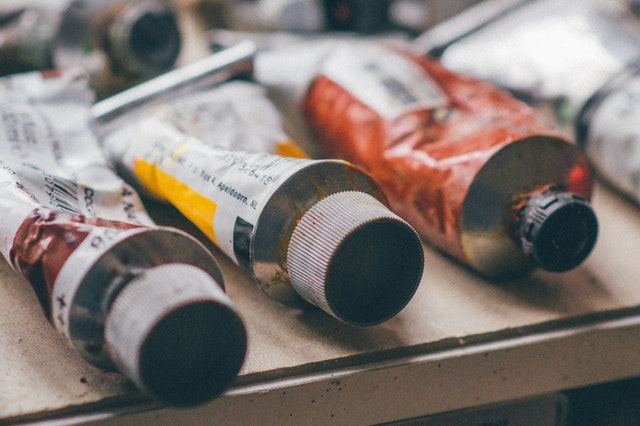
In this post, we will discuss the Oil Painting Glazing Techniques. Included below are several videos as well as step by step tutorials and lessons from around the Web, that discuss how to glaze with oil paint.
Glazing is the process of applying a thin layer of translucent or transparent oil paint over a dry opaque layer of oil paint, which creates an effect unlike any other.
Light travels through the transparent or translucent layer of oil paint and bounces off the opaque layer creating a sort of glowing effect that is very difficult to create with other oil painting techniques.
The effect is known as “Optical Color Mixing”. Colors are not mixed together physically on a palette or canvas, but are instead mixed optically through the various layers of glazes.
Learn all about this oil painting technique through the various videos and tutorials that I have collected below. Enjoy!
Oil Painting Glazing Techniques – Video Tutorials
Glazing : Oil painting techniques – how to glaze with oil paint
Glazing, a technique that gained prominence with the advent of oil painting, allows artists to explore the visual depth achieved through transparency. Despite its historical overuse, leading to a somewhat outdated reputation, Floren argues that glazing still holds potential for creating eye-catching works.
The process involves applying transparent or semi-transparent paint layers over a completely dried layer, known as underpainting. This layering can create visual depth and intensity of color that is difficult to achieve otherwise. Floren explains the science behind why glazed surfaces appear more vibrant: glossy surfaces reflect light more directionally, enhancing color intensity, especially in darker hues.
Floren offers practical advice for glazing, emphasizing the need for control when applying pigment and the right brushes for precise application. He discourages the pursuit of special mediums for glazing, advocating instead for using any transparent medium following the ‘fat over lean’ rule. Highlighting the distinction between chromatic and transition glazing, Floren demonstrates how using each can enhance the painting’s depth, color intensity, and realism.
Chromatic glazing adds vibrant colors over an underpainting, while transition glazing focuses on softening edges and improving form transitions. Throughout, he underscores that glazing’s effectiveness is contingent on a solid underpainting, reminding artists that no amount of glazing can compensate for foundational painting flaws. Floren’s insights offer a nuanced understanding of glazing’s role in modern painting, presenting it as a valuable, albeit optional, technique in an artist’s repertoire.
Visit the Artist’s Youtube Channel Here
Glazing: Painting as the Old Masters Painted
By Stefan Baumann
In this video, Stefan focuses on the glazing technique in oil painting, distinguishing it from a wash and explaining its use to alter or enhance the color beneath another layer. Glazing, involving the application of a thin, transparent, or semi-transparent paint layer over another color, can vary in opacity and requires knowledge of which paints offer transparency.
The instructor states that adding more oil to paint can achieve transparency, but the binder, typically linseed oil, is crucial for ensuring the paint adheres to the canvas. The discussion extends to the science of paint composition, highlighting the role of linseed oil in binding pigment to create oil paint and the effect of turpentine in diluting paint’s adherence.
Furthermore, the video explores the historical context of glazing, tracing back to the intricate processes used by the Old Masters, who valued the depth and intensity of glazing added to their artworks. These artists often layered multiple glazes, waiting for each to dry, a time-consuming method that resulted in the vivid, enduring color that defines classic works.
The importance of experimenting with various oils and mediums to achieve desired transparency and color effects is discussed, along with the need for patience and precision in layering glazes. This overview of glazing offers viewers insights into this painting technique’s technical and artistic aspects, encouraging experimentation and a deeper understanding of oil painting’s possibilities.
Visit the Artist’s Youtube Channel Here
Glazing Demo
By Marc Dalessio
In this video, artist Marc Dalessio explains how to glaze with oil paint. Glazing involves putting thin, somewhat see-through layers of paint on top of a base layer that has already dried. This approach was prevalent among the great painters of the past because it gave their artwork more depth and shine. In contrast, today’s outdoor painters often choose quicker methods, which means glazing isn’t as common because it requires a lot of patience. The paint needs to completely dry, which can take up to six months, to prevent the artwork from getting damaged, like cracking.
The instructor gives examples of how glazing can enhance a landscape painting. For instance, adding a slight red glaze can make distant mountains feel warmer, almost glowing, without losing any of the original painting’s detail. Another use of glazing is to create the effect of mist in a valley by combining blue and white, adding to the sense of atmosphere. Although glazing adds a complex and rich quality to paintings, it comes with challenges. If the underlying paint isn’t fully dry, the new layer of glaze might peel off or cause cracks. Despite these challenges, glazing can significantly enrich a painting, giving it a luminous quality and sophistication reminiscent of the masterpieces from history.
Articles on Glazing from the Web
Painting Glazes: An Oil Painter Reveals His Glazing Secrets
Leave a Reply